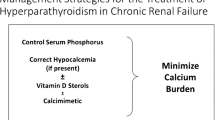Abstract
The study addresses the challenge of treating secondary hyperparathyroidism (SHPT) in chronic kidney disease (CKD) patients, focusing on the cost-effectiveness of surgical versus pharmacological interventions. Conducting a retrospective analysis on 152 CKD patients with SHPT at the Third People's Hospital of Chengdu, the study matched 80 patients into two groups: 40 undergoing parathyroidectomy with autotransplantation (PTX + AT) and 40 treated with calcimimetics. PTX + AT was more effective in alleviating symptoms, particularly bodily pain, and demonstrated greater cost-effectiveness over a long-term period compared to calcimimetics. This was especially significant in patients with PTH levels > 1800 pg/mL and hyperphosphatemia. Despite similar initial costs, PTX + AT led to a substantial decrease in expenses during the 2–5 years post-treatment period, PTX + AT results in an ICER of -RMB 26.71/QALY for the first post-treatment year and -RMB-111.9k/QALY for the 2–5 year period, indicating cost-effectiveness with reduced long-term costs. The study also found an increased economic burden in managing patients with hyperphosphatemia. Surgical intervention (PTX + AT) is advocated as the primary treatment strategy for severe SHPT in CKD patients, owing to its long-term economic and clinical advantages. The results underscore the need for a severity-based approach in treating SHPT.




Similar content being viewed by others
Data Availability
The datasets used and/or analysed during the current study available from the corresponding author on reasonable request.
References
Shireman TI, Almehmi A, Wetmore JB, Lu J et al (2010) Economic analysis of cinacalcet in combination with low-dose vitamin D versus flexible-dose vitamin D in treating secondary hyperparathyroidism in hemodialysis patients. Am J Kidney Dis 56(6):1108–1116. https://doi.org/10.1053/j.ajkd.2010.07.012
Belozeroff V, Lee A, Tseng S et al (2013) Cost per responder analysis in patients with secondary hyperparathyroidism on dialysis treated with cinacalcet. J Med Econ 16(9):1154–1162. https://doi.org/10.3111/13696998.2013.826665
Bellorin-Font E, Vasquez-Rios G, Martin KJ (2019) Controversies in the Management of Secondary Hyperparathyroidism in Chronic Kidney Disease. Curr Osteoporos Rep 17(5):333–342. https://doi.org/10.1007/s11914-019-00533-x
Barbuto S, Perrone V, Veronesi C et al (2023) Real-world analysis of outcomes and economic burden in patients with chronic kidney disease with and without secondary hyperparathyroidism among a sample of the Italian population. Nutrients 15(2):336. https://doi.org/10.3390/nu15020336
Evenepoel P, Jørgensen HS (2022) Parathyroidectomy versus calcimimetic: the lower the PTH the better? J Clin Endocrinol Metab 107(8):e3532–e3533. https://doi.org/10.1210/clinem/dgac211
Rroji M, Spasovski G (2018) Calcimimetics versus parathyroidectomy: what is preferable? Int Urol Nephrol 50(7):1271–1275.https://doi.org/10.1007/s11255-018-1838-5
Schneider R, Kolios G, Koch BM et al (2010) An economic comparison of surgical and medical therapy in patients with secondary hyperparathyroidism–the German perspective. Surgery 148(6):1091–1099. https://doi.org/10.1016/j.surg.2010.09.009
Lorenz K, Bartsch DK, Sancho JJ et al (2015) Surgical management of secondary hyperparathyroidism in chronic kidney disease–a consensus report of the European Society of endocrine surgeons. Langenbecks Arch Surg 400(8):907–927. https://doi.org/10.1007/s00423-015-1344-5
Long AN, Dagogo-Jack S (2011) Comorbidities of diabetes and hypertension: mechanisms and approach to target organ protection. J Clin Hypertens (Greenwich) 13(4):244–251. https://doi.org/10.1111/j.1751-7176.2011.00434.x
Komaba H, Fukagawa M (2018) Secondary hyperparathyroidism and protein-energy wasting in end-stage renal disease. Ther Apher Dial 22(3):246–250. https://doi.org/10.1111/1744-9987.12683
Danese MD, Belozeroff V, Smirnakis K et al (2008) Consistent control of mineral and bone disorder in incident hemodialysis patients. Clin J Am Soc Nephrol 3(5):1423–9. https://doi.org/10.2215/CJN.01060308
Slinin Y, Guo H, Gilbertson DT et al (2011) Prehemodialysis care by dietitians and first-year mortality after initiation of hemodialysis. Am J Kidney Dis 58(4):583–90. https://doi.org/10.1053/j.ajkd.2011.03.032
Funding
No funding.
Author information
Authors and Affiliations
Contributions
WenJie Zhang: Formal analysis, Investigation, Methodology, Writing—original draft, Jian Wu: Conceptualization, Writing—review & editing, Hailiang Ren: Data curation, Software, Qianxiu Liao: Data curation, Investigation.
Corresponding author
Ethics declarations
Conflict of interest
No financial conflicts of interest were reported by the authors WenJie Zhang, Hailiang Ren,Qianxiu Liao,Jian Wu.
Human and Animal Rights and Informed Consent
This study was conducted in accordance with the ethical standards of the institutional and national research committee and with the 1964 Helsinki Declaration and its later amendments or comparable ethical standards. All procedures performed in this study involving human participants were in line with the ethical standards of the institutional research committee at the Third Hospital of Chengdu and the national research council. Informed consent was obtained from all individual participants involved in the study. Participant data were de-identified and confidentiality was ensured throughout the study and subsequent data analysis process.This study did not involve any animals.
Additional information
Publisher's Note
Springer Nature remains neutral with regard to jurisdictional claims in published maps and institutional affiliations.
Rights and permissions
Springer Nature or its licensor (e.g. a society or other partner) holds exclusive rights to this article under a publishing agreement with the author(s) or other rightsholder(s); author self-archiving of the accepted manuscript version of this article is solely governed by the terms of such publishing agreement and applicable law.
About this article
Cite this article
Zhang, W., Ren, H., Liao, Q. et al. Cost-Effectiveness and Clinical Outcomes of Secondary Hyperparathyroidism Treatments in Patients with Chronic Kidney Disease. Calcif Tissue Int 114, 368–376 (2024). https://doi.org/10.1007/s00223-024-01187-3
Received:
Accepted:
Published:
Issue Date:
DOI: https://doi.org/10.1007/s00223-024-01187-3




